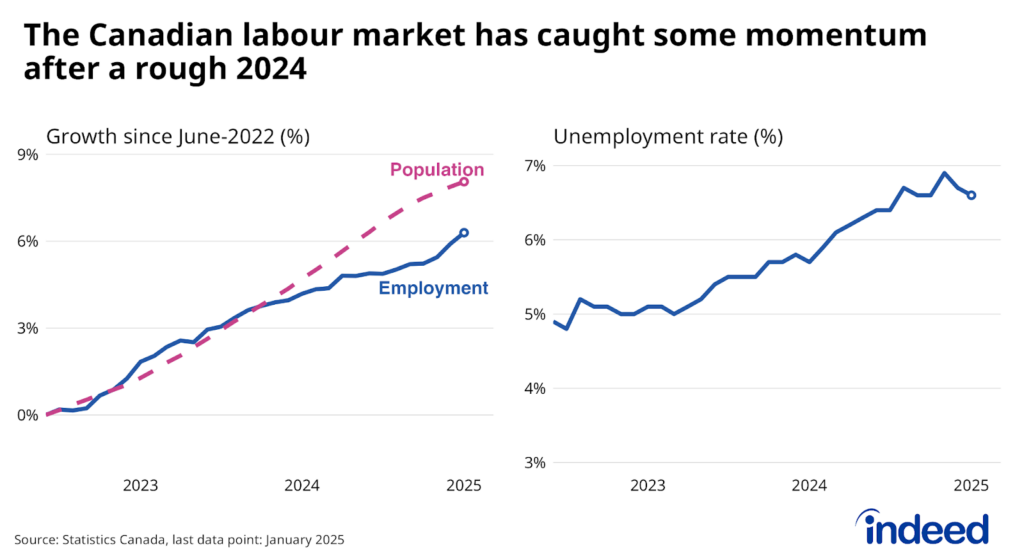Key points:
- Labour market mismatch refers to the gaps between the skills, interests, and experience of job seekers and the types of workers employers are looking to hire.
- We assess mismatch in the Canadian labour market by comparing the distribution of recent job titles on job seeker resumes posted on Indeed with that of the types of job openings posted by employers.
- Gaps between job seeker experience and job postings are prevalent, but the mismatch between the two has narrowed slightly since 2014.
- Jobs in tech, healthcare, and retail trade are among those for which the share of job postings is greater than the share of job seekers with recent experience in those fields.
- By contrast, there’s a relative surplus of job seekers who’ve worked as customer service reps, food servers, and general labourers.
In the Canadian labour market, the balance between job seekers and job openings ranges considerably across occupations. Some positions see more job seekers competing for relatively few roles, while others have relatively few candidates compared with job vacancies.
Economists often refer to these gaps across jobs as labour market mismatch. One concern is that the recent growth in employer reports of hiring difficulties reflects increasing mismatch between the skills, interests, and experience of job seekers and the kinds of positions employers are trying to fill.
Indeed data offer a unique way to measure the extent of mismatch in the Canadian labour market. We can compare the distribution of recent job titles that job seekers have put on their resumes with that of the positions employers post on Indeed. Using this method, we find that, despite reports of a tougher hiring environment, mismatch between work experience and employer demand does not appear to have risen in recent years.
Gaps between resumes and postings are quite common, but mismatch between the two has actually narrowed slightly since 2014. Consistent with this, while reports of difficulties finding skilled labour have increased, they’re also up for other types of workers, a sign of a generally tightening labour market.
Even though mismatch hasn’t widened, gaps between job seekers’ experience and the roles employers aim to fill will likely always be a part of any economy. So where is mismatch most visible today in Canada? Jobs in tech, healthcare, and retail trade are among those with a greater share of job postings than experienced job seekers. By contrast, there’s a relative surplus of job seekers who’ve worked as customer service reps, food servers, and general labourers.
Some workers in roles with relatively fewer opportunities may be able to switch to jobs for which demand is higher. But others might not have the skills to make the transition. Mismatch will always be present in the Canadian labour market. It has eased in recent years as the economy has improved, but it will be important to see how it evolves with future technological change and the aging of the Canadian population.
Comparing job postings with job titles on resumes
To measure mismatch, we compare the prevalence of job titles in the resumes of active job seekers with the titles of posted job openings. Looking across thousands of job titles, roles contribute to our mismatch index by having either a relatively high or low share of job postings compared with the appearance of those roles on resumes.
Overall, we find a substantial level of mismatch in the Canadian labour market. In December 2018, 31% of job seekers would have had to change their role to eliminate the resume-job posting gap. While switching jobs might be feasible in some cases, in others, individual job seekers may not have the right skills or experience.
Our analysis also finds that mismatch has shrunk somewhat in recent years, easing 12% between December 2014 and December 2018. Much of the decline occurred in 2017, which was a banner year for job growth, according to the Labour Force Survey. Over this same period, the share of employers reporting labour shortages in the Bank of Canada’s Business Outlook Survey rose to 37% from 22%.

Mismatch has eased somewhat in part because job postings have increased at both the higher- and lower-skilled segments of the labour market. Moreover, in some cases, a growing share of job seekers have recent experience in high-demand roles.
For example, while the share of job postings for typically tough-to-fill roles like software engineers are up, so too is the share of job seekers with recent experience in the role. Meanwhile, employers are also increasingly posting openings for roles like health care aides, housekeepers, and office administrators. These positions previously contributed to mismatch by having relatively more job seekers compared to their respective shares of job postings. However, as job postings for these roles has increased in recent years, the relative gap between job seekers and openings has narrowed.
In other words, the slight narrowing of mismatch is consistent with the broad-based tightening of the Canadian labour market. In particular, the decline in Canada’s unemployment rate reflects improvement across a wide range of occupations, not just for certain in-demand roles. This includes large unemployment drops in several manual labour occupations that have historically had the highest rates of joblessness.
Which jobs are the top contributors to mismatch?
Some jobs contribute to mismatch by having lots of job postings and relatively fewer qualified job seekers. Several of these roles are in-demand positions that are notoriously difficult to fill, including health care jobs like registered nurse and massage therapist, as well as tech roles like software engineer and full stack developer. More surprising is the high level of postings for retail sales associates and store managers relative to the share of job seekers with recent experience in these positions.

On the other side of mismatch, there is a surplus of job seekers relative to openings in several service sector occupations like customer service representative and cashier, as well as for manual labour positions. The large numbers of experienced people looking for work as servers and bartenders also face relatively less opportunity. Some seeking these jobs may be just starting their careers and could eventually migrate to positions in higher demand, but finding opportunity in these fields will likely be tougher than in other areas of the labour market.

Mismatch a long-term challenge for the Canadian labour market
Employers aren’t the only ones concerned about labour market mismatch and skills shortages—Canadian policymakers also pay close attention to these issues.The prevalence of mismatch in the Canadian economy suggests there’s scope to narrow these gaps. A labour market with low mismatch would have fewer job seekers struggling to find work in fields with less demand, while helping employers find workers for tough-to-fill jobs.
Some amount of mismatch will always be a part of the Canadian labour market. It will be interesting to see how it evolves with technological change and an aging population. For example, filling roles in the skilled trades could become tougher as the workforce ages. Still, these trends are long-term and shouldn’t be confused with cyclical developments, like the decline in both unemployment and mismatch as the overall economy has improved.
Methodology
We measure labour market mismatch by calculating a dissimilarity index between the job titles in the resumes of current job seekers and the titles of Indeed job postings. Jobs contribute to the index by accounting for either a higher or lower share of job postings compared with the share of job seekers with that title as the most recent position on their resume. For further details see this backgrounder on similar research using Indeed data from the US.
Our mismatch index is structured similarly to how mismatch is analyzed using public data in both the US and Canada. Measuring mismatch using public data typically involves calculating the dissimilarity between the number of people unemployed across occupations and the number of job vacancies of different occupations.
We calculate a quarterly mismatch measure beginning in the second quarter of 2015 using public Statistics Canada data (when job vacancy data by occupation became available). We compare the distribution of job vacancies across 37 different occupations from the Job Vacancy and Wage Survey with the number of unemployed workers, non-seasonally adjusted, from those occupations, using the Labour Force Survey. Overall, the trend in mismatch according to the Statistics Canada data is similar to what we find using Indeed resume and job posting data. Similar to the Indeed data, there is a significant mismatch between the recent work experience of the unemployed and the types of jobs employers are looking to fill. And both sources find these gaps have narrowed slightly in recent years.







